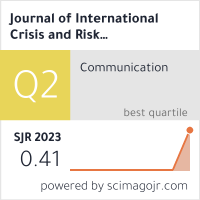Risk and Crisis Communication about Invisible Hazards
DOI:
https://doi.org/10.63278/jicrcr.v4i2.63Keywords:
sensemaking, narratives, COVID-19, crisis communication, health communicationAbstract
This article discusses differences between invisible and visible hazards, and how these differences can affect risk and crisis communication. Invisible hazards are risks that we cannot see, and often cannot touch, taste, nor smell. Examples are COVID-19, radongas, mold spores, or asbestos fibers. Invisible hazards are often uncertain, complex, and ambiguous risk problems. Results from a Norwegian study show that authorities need to be aware of the possible differences in risk perception among authorities, stakeholders, and the general public. Involving citizens, creating trust, and being honest is important for all risk and crisis communication. However, the less we know about a hazard, the more we need to rely on others to make decisions, and consequentlytrust is particularly important when dealing with invisible hazards.Downloads
Published
2021-10-04
Issue
Section
Articles
How to Cite
Risk and Crisis Communication about Invisible Hazards. (2021). Journal of International Crisis and Risk Communication Research, 4(2). https://doi.org/10.63278/jicrcr.v4i2.63










